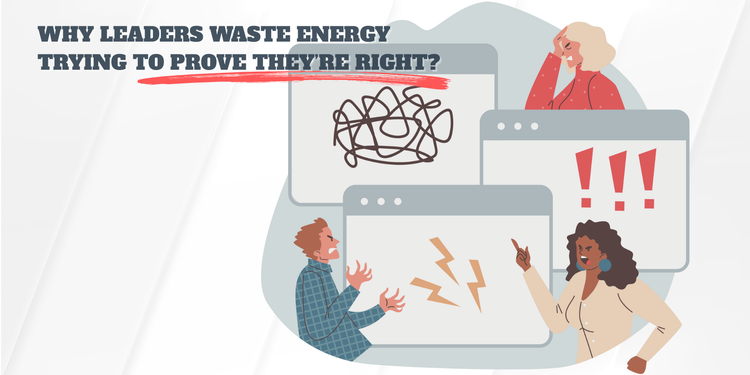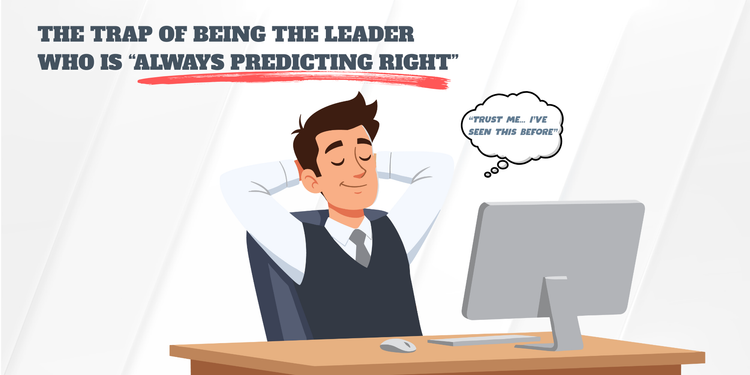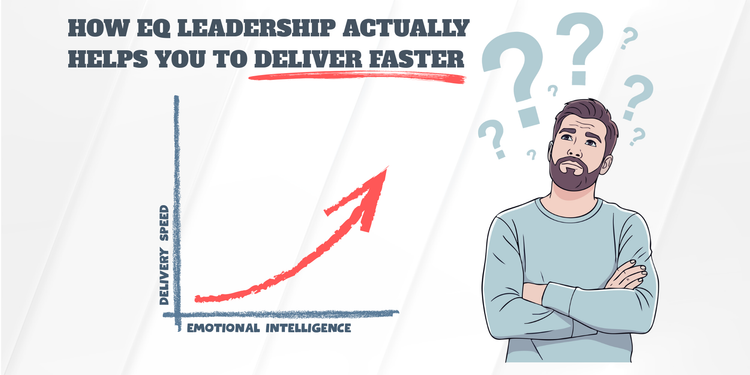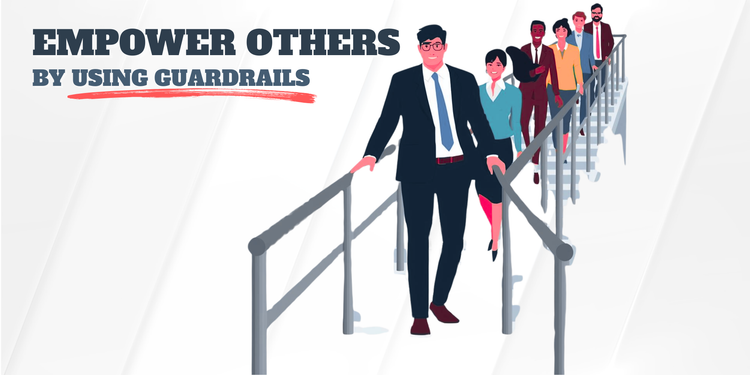Reading the Energy in the Room

Leaders listen for words.
But the truth of the room often shows up before anyone speaks.
In posture. In eye contact. In the pauses between responses.
That’s energy - and it tells you more than words ever could.
Think about it:
- A team says they are “fine” but the energy is flat.
- People nod along to a plan but the room kinda feels a bit tense.
- A meeting ends with agreement on paper, yet the atmosphere says otherwise.
If you ignore the energy, you lead by assumption.
You think people are aligned when they are resisting.
You push harder when they are already drained.
You miss signals of disengagement until it turns into attrition.
High EQ leaders approach this differently. They don’t just listen to what is said - they tune into what is felt. They treat the room like a living system that gives constant feedback.
Energy is not mystical or abstract. It is data. And when you know how to read it, you gain access to the truth underneath the words.
Why Energy Matters in Leadership
Energy is never neutral. Every room carries it, every team projects it, and every leader shapes it.
In high-pressure environments, it’s tempting to look only at hard signals: deadlines, decisions, dashboards. But those signals often arrive too late. Energy surfaces first.
- A team says “yes” but the atmosphere feels heavy.
- People nod to a plan but their tone is flat, their posture withdrawn.
- A meeting ends with alignment on paper, yet the energy says otherwise.
If you only listen to words, you miss the undercurrent. And it’s the undercurrent that determines whether your team will row in rhythm - or quietly paddle in opposite directions.
Why does this matter? Because energy is the earliest and rawest feedback you’ll ever get as a leader. It is instant. It shows you alignment before it’s spoken. It signals resistance before it becomes conflict. It reveals fatigue before it turns into burnout. By the time these things show up in delivery metrics or attrition reports, the damage is already done.
Energy also spreads faster than words. When one person enters a room drained, the group feels it. When tension lingers between two people, the atmosphere changes for everyone.
This is why EQ leaders pay attention to energy. They don’t dismiss it as vague or mystical. They treat it as data - data that shapes how people experience the work, and how effectively they will deliver it. Reading energy well allows you to intervene early, guide with awareness, and adjust your own presence so the team can perform at its best.
When you know how to tune into the room, you don’t just lead tasks. You lead the emotional current that makes those tasks possible.
The Risks of Misreading Energy
Energy is always present, but it’s easy to interpret it the wrong way. When leaders misread the signals, they act on assumptions instead of reality - and the cost shows up later in performance, trust, and retention.
1. Mistaking compliance for commitment
The room feels flat, but because no one objects, you assume alignment. In reality, people are checked out. They may follow instructions, but without ownership or enthusiasm. The project moves forward on paper, but stalls in practice.
2. Ignoring subtle signs of resistance
People nod, but their tone is clipped. They agree, but their posture is tense. If you miss these cues, resistance goes underground. Instead of voicing concerns, people disengage quietly - slowing down work, second-guessing decisions, or withholding effort.
3. Overlooking rising fatigue
Energy often dips before burnout becomes visible. If you read exhaustion as laziness, or low mood as “just a bad day,” you miss the early warning signs. By the time performance drops or someone resigns, it’s too late.
4. Projecting your own state onto the room
Leaders often misread energy because they confuse it with their own. If you’re calm, you assume the team is calm. If you’re stressed, you assume everyone else feels the same. Without checking in, you risk leading from projection instead of perception.
Misreading energy doesn’t just create blind spots - it creates mistrust. When people feel their signals are invisible, they stop sending them. And when the room goes emotionally silent, you lose one of the most valuable sources of truth available to you as a leader.
The Psychology of Energy
Energy in a room is not mystical - it’s psychological. Humans are wired to pick up on emotional states through nonverbal cues: tone, posture, eye contact, pace. These signals tell us instantly whether we’re safe, respected, or under threat.
Groups amplify this through emotional contagion. One person’s frustration can drag everyone down. One person’s calm can steady the whole team. Neuroscience shows this happens through mirror neurons - our brains literally mirror the emotions we see.
Leaders are the most contagious. If you walk in tense, the team carries that tension. If you project calm, they borrow your confidence.
That’s why EQ leaders pay close attention to energy. It’s not intuition - it’s awareness of how emotions spread, and how much power you have to shape them.
What EQ Leaders Do Differently
Most leaders focus on words. They listen to what people say and miss what people feel. EQ leaders widen the lens. They read the room as carefully as they read the agenda.
They scan for signals. Is the silence calm or tense? Is the body language open or closed? Does the tone of agreement feel engaged or flat?
They name what they notice. Instead of pushing ahead, they say things like:
- “I sense some hesitation - is there something we haven’t addressed?”
- “The energy feels low - should we pause before we push forward?”
They adjust their presence. If the room is tense, they slow down. If the group feels drained, they bring energy without forcing it. If emotions are high, they steady themselves before speaking.
The difference is that EQ leaders treat energy as data. They don’t ignore it, and they don’t overreact to it. They use it to guide conversations toward truth, alignment, and safety.
The Main 6 Energy States of Teams
1. Flow Energy
- What it is: Alignment, focus, and healthy momentum.
- How it looks: Open body language, engaged tone, natural back-and-forth.
- Risks: Can slip into autopilot – people stop challenging assumptions.
- Leader response: Protect it, but inject curiosity to avoid groupthink.
2. Friction Energy
- What it is: Visible tension or disagreement.
- How it looks: Crossed arms, clipped tone, faster pace, interruptions.
- Risks: Left unchecked, it grows into toxic conflict or silent avoidance.
- Leader response: Normalize dissent. Channel tension into constructive debate.
3. Fatigue Energy
- What it is: Low mood, drained motivation, or quiet burnout.
- How it looks: Flat tone, slouched posture, fewer contributions.
- Risks: Burnout, disengagement, or turnover.
- Leader response: Slow down, adjust workload, reconnect people to purpose.
4. False Harmony Energy
- What it is: Outward agreement masking hidden resistance.
- How it looks: Polite nods, forced smiles, silence after decisions.
- Risks: Passive resistance, lack of ownership, stalled execution.
- Leader response: Ask into the quiet. Create safety for disagreement. Confirm real alignment.
5. Chaos Energy
- What it is: Scattered focus, constant context-switching, lack of clarity.
- How it looks: Side conversations, people talking over each other, ideas with no direction.
- Risks: Decision paralysis, wasted effort, exhaustion.
- Leader response: Ground the room. Clarify priorities. Create structure before moving forward.
6. Hope Energy
- What it is: Optimism, resilience, and belief in the future despite challenges.
- How it looks: Encouraging tone, willingness to volunteer, people leaning in during tough times.
- Risks: If not paired with realism, it can slide into blind optimism or denial of risks.
- Leader response: Nurture it. Anchor hope in concrete next steps. Balance positivity with honesty.
Why This Framework Matters
Flow, Friction, Fatigue, False Harmony, Chaos, and Hope – each state tells a different story about how your team is really experiencing the work. The EQ leader doesn’t just hear words. They tune into these energy states, name them, and respond in ways that move the group toward alignment and trust.
Practical Tips for Reading Energy
Energy is always present – but it takes practice to notice and interpret it. Here are simple habits you can start using right away:
- Pause before speaking – Scan the room. Notice posture, tone, and whether silence feels heavy or light.
- Check in openly – Say what you see: “The energy feels low – what’s on people’s minds?”
- Track patterns – Is a teammate consistently quiet? Does tension always rise in certain meetings? Patterns reveal the truth.
- Balance the mood – If the room is tense, slow down. If it’s scattered, anchor priorities. If it’s drained, pause and reset.
- Adjust your own presence – You are the most contagious person in the room. Regulate yourself first.
- Invite reflection – Ask: “What’s the mood in the group right now?” Simple, but it surfaces what words often hide.
Final Word
Words tell you what people think.
Energy tells you what they feel.
Leaders who only listen to words lead by assumption. Leaders who read energy lead with awareness.
Flow, Friction, Fatigue, False Harmony, Chaos, and Hope – each state is a signal. Each one carries risks and opportunities. The EQ leader doesn’t fear those signals. They use them.
Because in the end, leadership isn’t just about managing tasks. It’s about guiding the emotional current that makes those tasks possible.
More Ways I Can Support You?
Work With Me 1:1 – Fast-Track Your Leadership Growth!
If you're serious about accelerating your career and becoming the kind of leader people respect and follow, I offer premium 1:1 coaching tailored to your needs. My coaching focuses on:
👥 Build stronger stakeholder relationships!
🗣️ Increase your confidence and influence!
📊 Have higher retention and engagement!
🕊️ Become a smooth conflict resolver!
🚀 Improve your team’s performance!
🌟 Build your leadership reputation!
🎯 Get promoted a lot faster!
🧘 Avoid burnout and stress!
This isn’t just theory, it’s actionable, personalized coaching based on real-world leadership experience.
Let’s Build Emotionally Intelligent Leaders, Together
I’d love to hear from you:
What’s the biggest leadership challenge you’re facing right now?
Hit reply and let me know. I read every response.
If this resonates with you, share this newsletter with a friend or colleague who could benefit from it.
You can also follow me on LinkedIn for more real-world leadership insights.
Let’s build the future of leadership one insight at a time!
Thanks for reading all the way through!
– Djordje
Founder, The Chronicles of a High-EQ Leader.





Member discussion